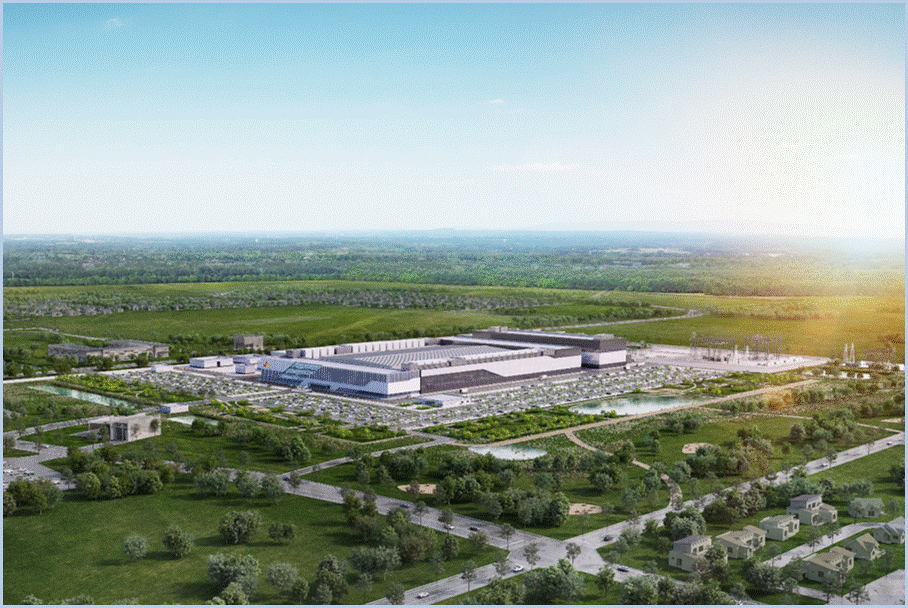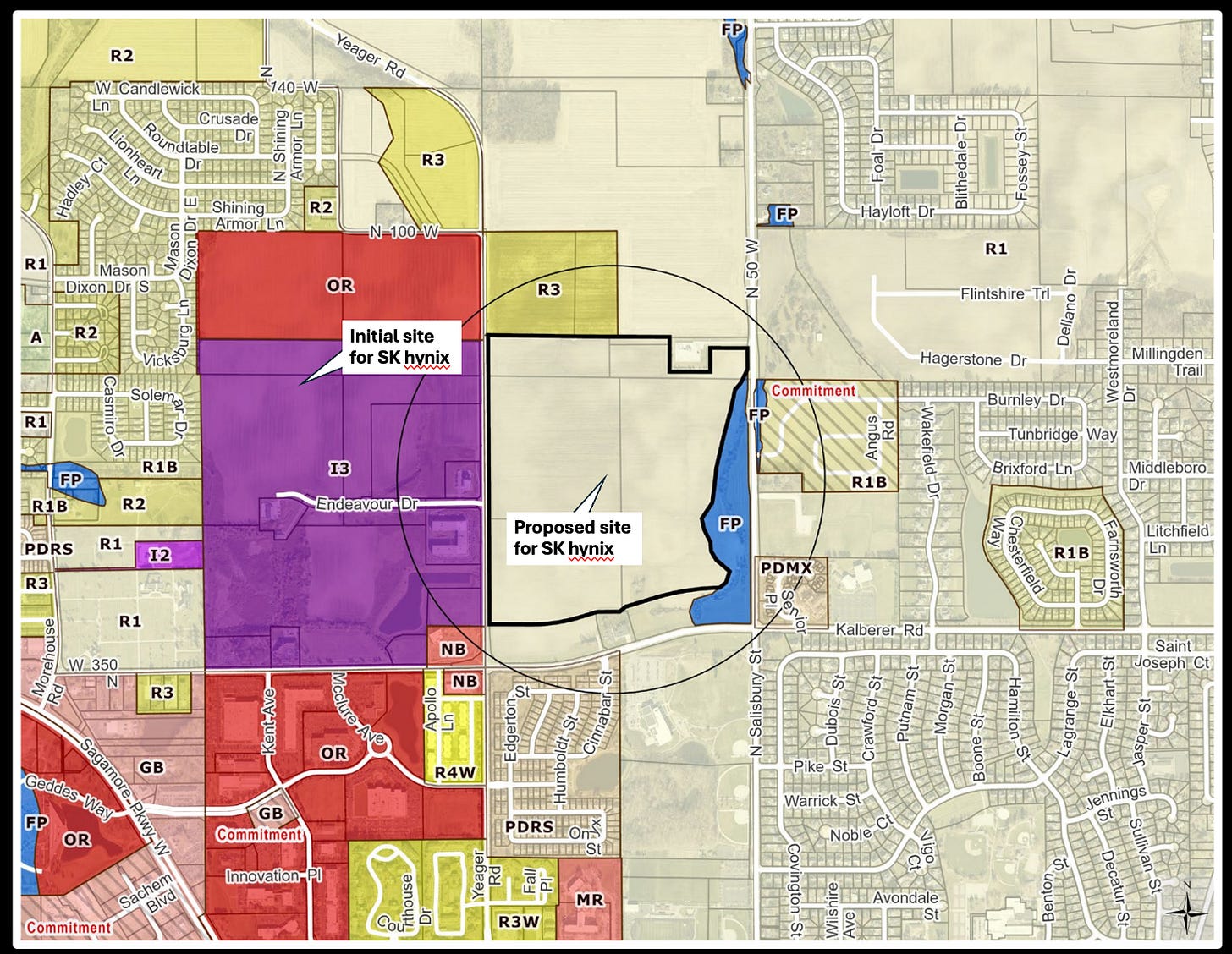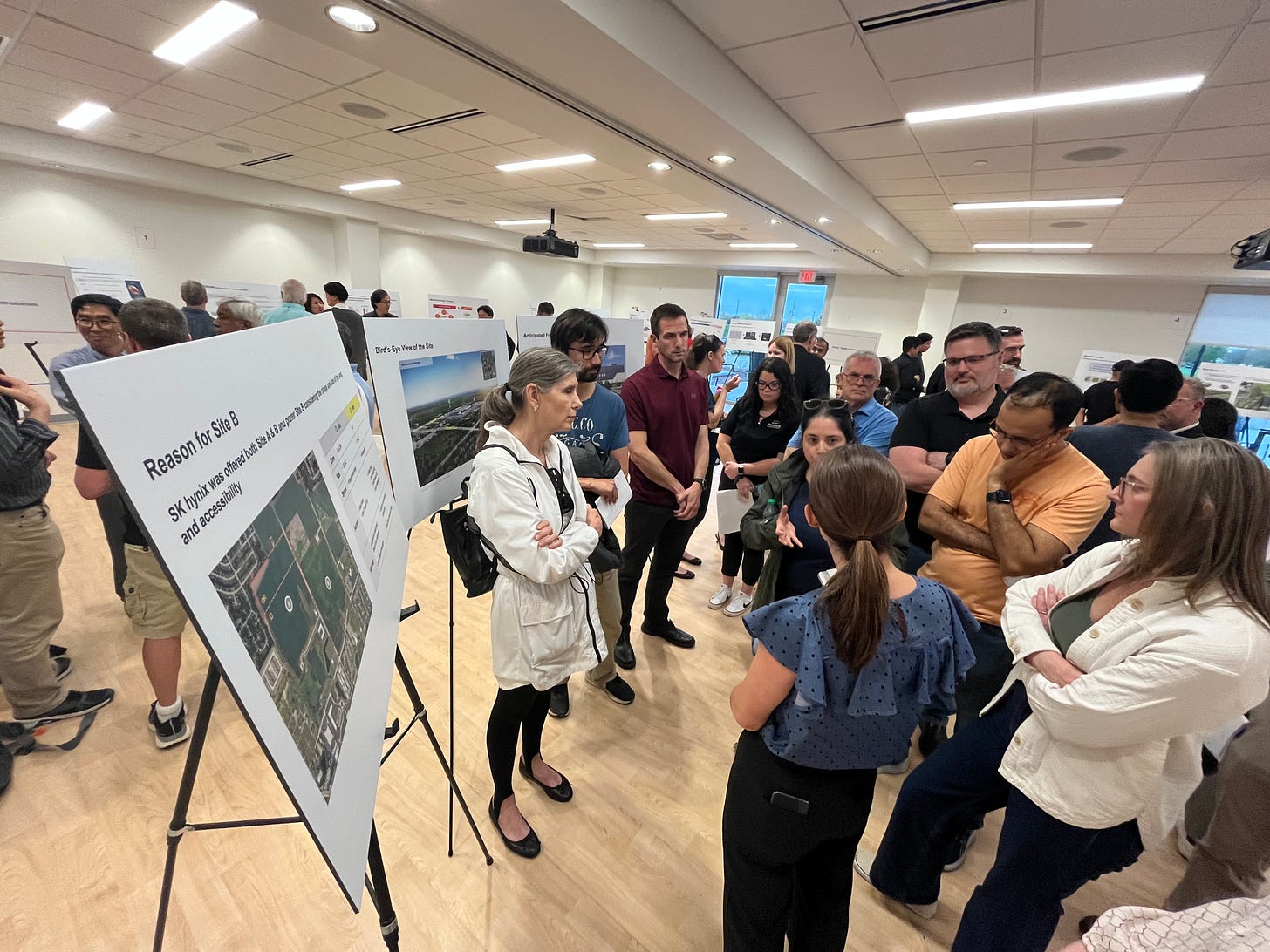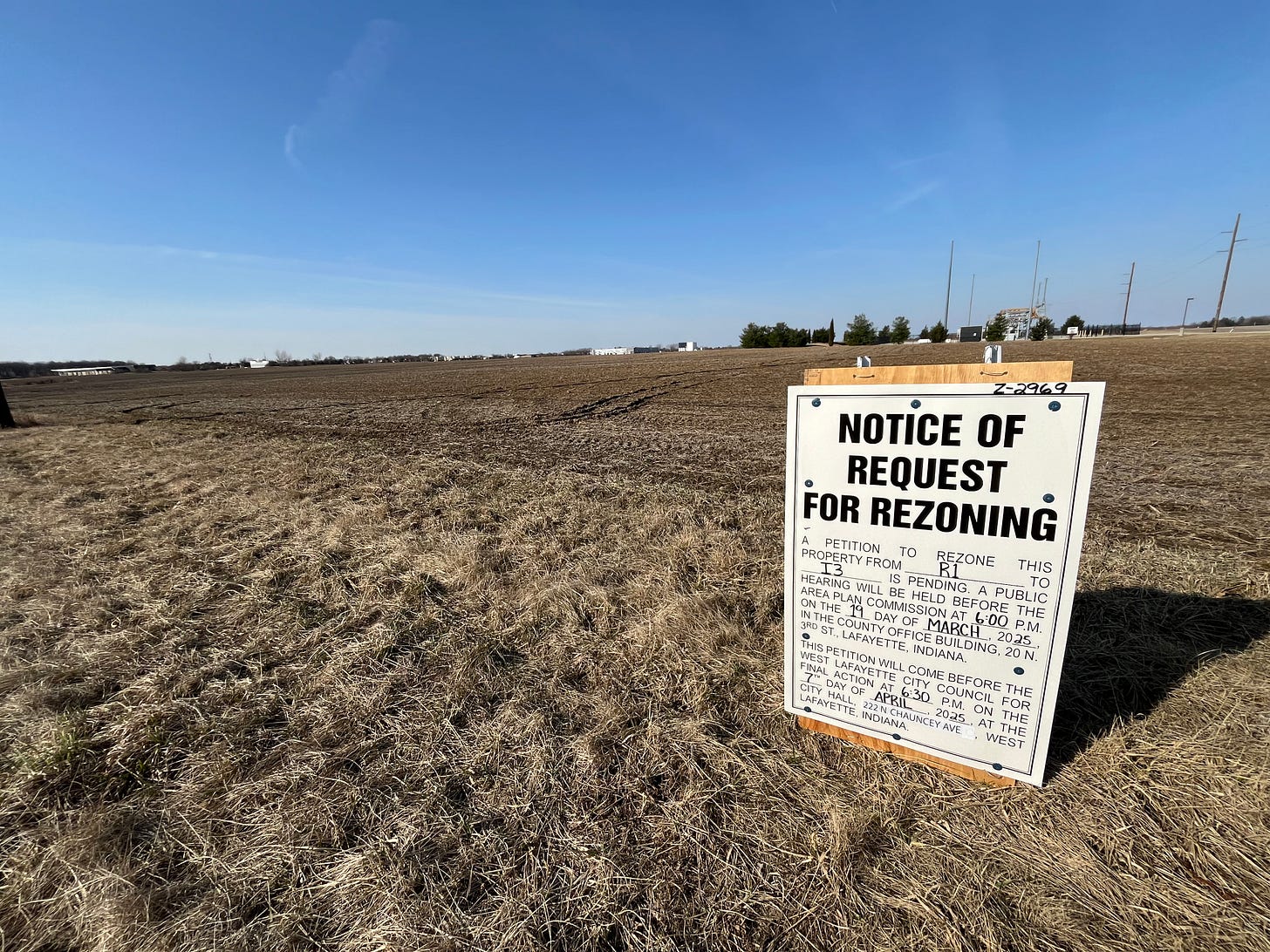Q&A: SK hynix on chemicals, whether another WL site would work for $3.87B chip facility and more
Here are questions BiL posed after the first two community meetings on SK hynix's $3.87B plan, with responses officials offered Friday evening, as neighborhood protest continues

Heading into Saturday morning’s third of three community meetings SK hynix is using to make its case for a $3.87 billion advanced chip packaging and R&D facility in West Lafayette, officials with the South Korean company addressed a series of questions collected by Based in Lafayette from residents pushing back on a rezoning request up for a pivotal vote Monday.
Among them: What chemicals will be used at the facility, how waste will be processed, what will be done about traffic and whether there is any chance to look at any other locations in or near West Lafayette for a 430,000-square-foot facility expected to open by 2028 and that would employ 1,000 people to assemble high-bandwidth memory used in AI applications.
Up first next week: A request to rezone 121 acres in the Purdue Research Park – north of Kalberer Road, between Yeager Road and Salisbury Street/County Road 50 West – from residential to industrial uses is scheduled for a final vote. SK hynix officials call that Site B and say that’s their preferred location for a facility. SK hynix officials continue to say the company will return to planning for what it calls Site A – just on the other side of Yeager Road, on acreage already zoned appropriately – if the zoning request fails.
The West Lafayette City Council is scheduled to vote on that Monday.
Meanwhile, neighbors have spent weeks going door-to-door, gathering more than 2,400 signatures on petitions, questioning why a semiconductor project of that size is being considered so close to some West Lafayette residential areas.
Here are questions Based in Lafayette submitted after the first two community meetings, with responses that SK hynix officials offered Friday evening. Details about Saturday’s community session and the city council meeting follow.
Question: After two community meetings, are SK hynix officials feeling confident about the rezoning vote scheduled for May 5? What more, if anything, do they feel they need to do to make their case?
SK hynix: SK hynix is committed to promoting transparent and constructive discussions with the local community through three consecutive community meetings. The goal has been to provide accurate information to the stakeholders as well as local neighborhoods as a member of the West Lafayette community and to ensure a clear vision regarding project plans.
On April 11, we held the first community information session, followed by the second science fair-style session, where we provided explanations about the project and engaged with the local community. Additionally, we launched a dedicated website (neuron.prf.org) to allow those interested in the project to access relevant information and FAQs at any time. Our third community meeting is on Saturday, May 3, at West Lafayette City Hall
While the outcome of the rezoning vote scheduled for May 5 still remains unknown, we will continue to make every effort to achieve the best possible results in collaboration with esteemed partners including Purdue.
KEEP UP WITH WHAT YOUR FRIENDS AND NEIGHBORS ARE TALKING ABOUT. GET A SUBSCRIPTION TO THE BASED IN LAFAYETTE REPORTING PROJECT. FREE AND FULL-ACCESS OPTIONS, DELIVERED STRAIGHT TO YOUR INBOX.
Question: Is SK hynix still committed to building at Site A if the Site B rezoning fails?
SK hynix: SK hynix is confident that its advanced packaging facility will greatly benefit Purdue, West Lafayette and the state of Indiana.
We have been offered investment attractions at both the original site (Site A) and the opportunity to rezone a neighboring site (Site B). The site for rezoning was originally scheduled to be a future supply chain partner area.
However, from SK hynix’s perspective, Site B has a more optimal layout, making it significantly more efficient in terms of land utilization. We are committed to making every possible effort to ensure that the rezoning is approved.
However, SK hynix will use Site A as originally planned if the rezone is unsuccessful.
Question: Was a site in Purdue’s Discovery Park District, west of the university’s campus, ever offered during site selection – whether before or after the April 2024 announcement? Would that site work for SK hynix’s plans? Why or why not?
SK hynix: We have not received any proposals from the state of Indiana, the city of West Lafayette or Purdue University suggesting an alternative site beyond the current location.
Question: Would it be possible this far into the planning to shift to that location in the Discovery Park District and still remain close to R&D partnerships with Purdue
SK hynix: Through discussions with the city of West Lafayette and PRF, we received feedback indicating that, after comprehensive consideration of infrastructure readiness, the land area required for fab construction and other key factors, there are no viable alternative sites within West Lafayette aside from the current location.
Additionally, seeking a new site outside of West Lafayette would mean returning the project to its early stages, which is not under consideration at this time.
Question: SK hynix closed a facility in Oregon in 2008 due to market conditions. Some reporting suggested that the community there was left with a site difficult to reuse in any way – along with reporting that suggested that the community might have been better off in the long run without the environmental concerns from the facility. What is SK hynix’s take today on what happened to its U.S. facility in Oregon in 2008? And what hopes or guarantees are being built into the West Lafayette plans to keep that from happening here?
SK hynix: The chemicals used in semiconductor manufacturing will be managed in full compliance with the procedures established by the U.S. environmental authorities.
The Eugene facility was properly decommissioned in 2008 during the Great Recession in accordance with legal procedures, and any remaining chemicals were either returned through licensed chemical management firms or disposed of following regulatory guidelines.
Given Oregon State and the city of Eugene’s strong environmental focus, the Eugene facility had carefully managed the import, use and discharge of chemical substances.
Question: First quarter 2025 earnings announced last week by SK hynix show a huge demand for high-bandwidth memory. What is the company’s plan to continue that sort of run, and can it stave off competition to guarantee its West Lafayette facility remains vital?
SK hynix: Our company maintains a competitive edge in the HBM market, driven by our technological leadership. Additionally, West Lafayette is home to numerous semiconductor research institutions, including Purdue University and Ivy Tech.
These factors played a key role in selecting West Lafayette as the project site. Moving forward, we will continue to collaborate with local partners to advance R&D efforts, developing core technologies essential for HBM and Advanced Packaging.
Question: Company officials, during community meeting sessions, mentioned small-scale accidents at its facilities, but maintained that none of those harmed nearby residents. What happened in these cases:
A construction fire in Icheon that killed dozens in 2020.
A fire at an SK hynix facility in China in 2013.
SK hynix: Construction Fire: The fire incident on April 29, 2020, was entirely unrelated to our company in Icheon. It was a warehouse fire involving a different company, and we have absolutely no connection to the incident in any capacity.
The fire at our China facility was contained within the Fab’s internal equipment, and the fire did not spread beyond the site premises.
To prevent similar incidents, we have implemented enhanced safety procedures, including redefining safe work protocols, monitoring gas supply with interlock mechanisms, strengthening emergency response systems, reinforcing fire suppression facilities, and applying non-combustible materials to prevent fire spread. Since these measures were introduced, no fire incidents have occurred in the past 12 years.
To mitigate risks related to fire, explosions and other incidents, we have established and actively operate a Process Safety Management (PSM) system. Through PSM, we conduct process hazard assessments, pre-operation inspections and process interlock controls to safeguard against fires, explosions and natural disasters. Additionally, we have developed emergency response plans and conduct regular emergency drills to minimize potential damage in case of an incident.
Question: What, if anything, has changed in that time to prevent or deal with these incidents? What can the city and neighbors expect in improved safety from the company, both in construction and in production?
SK hynix: In the event of an incident, we follow a structured process by convening an accident investigation committee to develop effective preventive measures, ensuring similar incidents do not recur. Additionally, we prioritize addressing identified safety risks through external assessments and inspections, such as the Responsible Business Alliance (RBA) review and Risk Survey for property insurance renewal.
Question: The FAQ and information at community meetings talk about fire and emergency measures. Will SK hynix have an emergency response team on site, or will that be reliance on West Lafayette Fire Department for fires, leaks or other incidents?
SK hynix: In Korea, the Emergency Response Team (ERT) undergoes regular training at government institutions such as the Central Fire Academy and the National Institute of Chemical Safety. This continuous training ensures they can effectively respond to various situations. Similarly, at the newly established Indiana facility, we are preparing to provide comprehensive training for local responders.
We plan to design a customized response system through close collaboration with the local fire department. This system will include fire detection and suppression technologies, joint monitoring equipment and regular coordinated drills with the fire department.
Within the Fab, we will operate a central control room to monitor detection equipment, along with an on-site emergency response team (F-ERT: Fab-Emergency Response Team). F-ERT will handle incidents such as minor carbonization or small leaks, while larger incidents exceeding certain thresholds will be managed through coordinated response efforts with the West Lafayette Fire Department.
Question: Neighbors have asked about this situation in 2016, involving health claims among its employees. (The Korea Times, 2016: “SK hynix, the world’s No. 2 memory chip producer, said Thursday that it has begun compensating some factory workers who’ve allegedly developed incurable diseases at the company’s workplaces.”) What was SK hynix’s approach to that? And what, if any, measures been put in place to address that over the past decade in its facilities, including the one planned for West Lafayette?
SK hynix: The illness mentioned in the article has not been confirmed to have a causal relationship with our workplace. However, in accordance with “Principle of Reserved Causality,” which is not bound by strict causation, and in fulfillment of our corporate social responsibility, we have decided to provide compensation.
Question: On truck traffic layout at the facility: What will the traffic patterns be — for deliveries, waste hauling, as well as employees — when the facility opens?
SK hynix: For Site B, we are planning to operate two main entrances on the Yeager Road for transportation of employees, logistics and waste hauling, etc., to minimize inconvenience to residents.
The city of West Lafayette is reviewing the possibility of expanding Yeager Road. Please check with the city for further details regarding Yeager Road.
Question: The company has described how a tanker truck is expected to transport toxic waste from the facility every two days. What will be in the tankers? The FAQs says they will go to appropriate recyclers. Where will that waste go, specifically? What will the tanker be carrying and what are those companies/types of companies that will be handling the material?
SK hynix: In Korea, alcohol and copper used in the HBM process are valuable resources, so they are collected and sent to external recycling companies for proper reuse.
The materials are typically transported in licensed tanker trucks, following Korean standards, and are processed or refined into other resource forms at the recycling company's site rather than within our facilities.
Similarly, at the West Lafayette facility, we plan to conduct external transportation, processing and recycling through licensed waste management companies and vehicles. To minimize community impact, we will carefully schedule truck dispatch times. Currently, in Korea, 25-ton tanker trucks are used for external transport once or twice per week, and the expected frequency of tanker truck operations at the West Lafayette site will be approximately one to two tanker truck per week.
Question: What all will go into an environmental impact study company officials said would happen after the site selection? And who will do it?
SK hynix: After selecting the site, the company plans to conduct an environmental impact analysis in accordance with NEPA (National Environmental Policy Act) guidelines and report the findings to the local community. Additionally, we are committed to complying with emission standards set by both local and federal regulations to ensure responsible environmental management.
Question: What will the reporting method for that be for the community to see?
SK hynix: NEPA documents are made publicly available in accordance with U.S. law.
Question: What is the list of chemicals SK hynix plans to use in its processes at the West Lafayette facility?
SK hynix: The materials used in our operations will be submitted to the Environmental Protection Agency (EPA) during the NEPA review process in accordance with regulatory requirements.
Question: How much of the toxic waste from that process will be handled on site? What will be released from the facility in other ways, and how?
SK hynix: All waste generated at the facility will be transferred to licensed waste management companies for proper disposal.
Liquid waste, approximately 40 tons per week (equivalent to two tanker trucks), will be safely processed at a specialized third-party facility rather than on-site.
No waste will be recycled within our facility.
In accordance with local regulations, waste will be temporarily stored at the facility’s resource circulation center before being handed over to waste management companies for disposal. Additionally, to minimize inconvenience to nearby residents, we will carefully schedule truck dispatch times during the transfer process.
Question: Will wastewater from the processes be treated on-site before being released to the city’s system? How will that process work and what pollutants or toxic waste would it remove before releasing? What would be left for the city to handle?
SK hynix: The discharged water (effluent) will be thoroughly treated to remove fluoride, copper ions and other substances, ensuring it meets and exceeds legal safety standards. This will not only comply with IWDP (Industrial Waste Water Discharge Permit) agreement conditions but also prevent any impact on the biological treatment processes at the city's public wastewater treatment facility.
As mentioned in previous briefings, there will be no discharge of mercury or lead whatsoever.
Wastewater will undergo primary treatment at the facility before being transferred to Lafayette's public treatment plant, where organic materials and other remaining substances will be fully processed before final discharge into the Wabash River.
Question: SK hynix officials have said in community meetings and in its FAQ that it will adhere to the Stockholm Convention when dealing with PFAS, known as forever chemicals. What about PFAS not covered by the Stockholm Convention? What, if any, PFAS will be used or produced at the West Lafayette facility? And what’s the plan to handle those before they are released into the waste stream?
SK hynix: SK hynix strictly prohibits the use of approximately 550 types of PFAS regulated under the Stockholm Convention and unequivocally ensure they are not utilized under any circumstances.
Furthermore, even when conducting comprehensive tests on PFAS components in wastewater from SK hynix’s operating plants in Korea, using Korean water quality testing methods equivalent to U.S. standards, PFAS is at a non-detect level.
To eliminate risks associated with PFAS, SK hynix is further implementing advanced treatment facilities, such as activated carbon filtration, to effectively control trace contaminants, including PFAS. Our treatment capabilities are designed to meet the EU’s strictest drinking water standards.
PFAS has not been detected at SK hynix’s facilities in Korea and highly advanced protocols and technologies, equivalent to those in Korea, will also be introduced at the West Lafayette facility.
Question: Neighbors have shared this account about emissions at an Intel semiconductor site in Oregon that left safety equipment off for two months in 2022, according to regulators there. What is SK hynix doing to guarantee that that isn’t a possibility in West Lafayette.
SK hynix: To prepare for potential malfunctions in air pollution control scrubbers, the company will install backup equipment to ensure proper treatment of emissions even in emergency situations.
In anticipation of any unexpected events, we plan to monitor operational parameters in real time to swiftly detect any abnormalities. Additionally, we are committed to maintaining close and continuous communication with residents regarding emission levels.
Question: What ways is SK hynix currently considering to contribute to the local community?
SK hynix: SK hynix plans to establish a Community Engagement Committee to better understand the needs of the local community, collaboratively address challenges and develop concrete initiatives that contribute to the local society.
The committee will be composed of members recommended by PRF, semiconductor experts, the city of West Lafayette and representatives from the local community, and the formation of the committee and the Community Engagement Program is expected to be completed by the end of July at the earliest.
The committee aims to strengthen relationships with key local stakeholders, provide insights and recommendations on various issues related to SK hynix and the region, and establish and implement community engagement initiatives that align with the needs of the local community.
The Community Engagement Program will be structured based on the “3S Framework,” incorporating input from committee members to refine its activities. The 3S Framework represents STEM Empowerment, School Engagement, and Sustainable Growth. Through this initiative, we plan to provide STEM and semiconductor education to local students, support school activities, and contribute to nonprofit and environmental protection programs within the community.
WHAT’S NEXT
COMMUNITY MEETING NO. 3 FOR SK HYNIX: The third of three community meetings on the SK hynix rezoning proposal will be 9 a.m. Saturday, May 3, will be at West Lafayette City Hall, 222 N. Chauncey Ave. According to a release Wednesday from the city, the meeting will be a mix of the previous two community sessions – a science fair-style poster session and informational stations will be up starting at 9 a.m., with a 10 a.m. panel discussion and Q&A with officials from the South Korean company. Seating will be limited to 150 people between the council chambers and city hall’s Bean Room, according to the city release. Anyone with questions or comments may submit those ahead of time at: neuron.prf.org/#contact
CITY COUNCIL VOTE: The West Lafayette City Council will meet at 6:30 p.m. Monday at city hall, 222 N. Chauncey Ave. On Tuesday, the city released the following guidelines about where overflow crowds can participate in public comment that night.
Q&A SITE FOR SK HYNIX’S PLANS: The South Korean semiconductor company and Purdue Research Foundation last week released a website with their plans for a $3.87 billion R&D and advanced chip packaging facility expected to open for production in 2028 and eventually employ 1,000 people in West Lafayette. The FAQ offers SK hynix’s answers to questions raised recently about site selection and the company’s approach to environmental, waste handling, traffic and other issues. According to the company, the website will include additional content in the coming days. For now, here’s a way into a page about “Project Neuron,” which was the code name used when recruiting SK hynix to the Purdue Research Park: neuron.prf.org/
MORE COVERAGE
Here are a few key moments in the timelines the rezoning request for SK hynix’s site in the past six weeks.
April 2024: ‘We won:’ Inside the chase for a $3.87B SK hynix chip facility in West Lafayette
March 20: Rezoning for $3.8B SK hynix facility gets thumbs down from APC
April 19: Neighbors take to streets to protest $3.87B SK hynix chip site in West Lafayette
April 23: A short timelines of public discussions about SK hynix’s site
April 24: West Lafayette Mayor Erin Easter: ‘Still confident in SK hynix.’ A Q&A
April 24: SK hynix’s 2.8 million-gallon-a-day water needs: Indiana American Water weighs in
April 25: SK hynix rezone: WL City Council moving closer to yes vote on $3.87B site?
May 1: GLC backs up its support for SK hynix, as pushback for $3.87B chip site continues
May 2: ‘Sometimes David wins:’ WL neighborhoods find ally in fight over $3.87B SK hynix site
Thank you for supporting Based in Lafayette, an independent, local reporting project. Free and full-ride subscription options are ready for you here.
Tips, story ideas? I’m at davebangert1@gmail.com.





🗳️ 🚫 The City Council should vote NO on the question of rezoning the R1 area to I3, keeping the industrial footprint to a minimum in this densely populated residential area.
Since SK hynix will build at Site A regardless (as stated multiple times), there's no need to expand the industrial zoning for unnamed, unknown supply chain partners who have yet to be evaluated and questioned.
That's the compromise in all of this: NO to the rezone.
Sadly, the environmental concerns being raised are answered only in the abstract or high level. I don't understand why SK hynix cannot provide the specific raw data and details from their existing packaging facilities. More in-depth discovery is being deferred to the NEPA (National Environmental Policy Act) and other processes.
And yet, even then, there will be unknowns as it isn't a complete and comprehensive analysis, but one governed by the current rules and regulations. We'll know more, but the picture will still be incomplete.
For example, one defense offered by SK hynix is adherence to the Stockholm Convention regarding 550 types of PFAS. However, are are over 7 million PFAS known (Per- and Polyfluoroalkyl Substances (PFAS) in PubChem: 7 Million and Growing, https://pmc.ncbi.nlm.nih.gov/articles/PMC10634333/).
"In 2021, the Organisation for Economic Co-operation and Development (OECD) revised the definition of PFAS to include any chemical containing at least one saturated CF2 or CF3 moiety. The consequence is that one of the largest open chemical collections, PubChem, with 116 million compounds, now contains over 7 million PFAS under this revised definition."
Obviously not all of them are used by SK hynix, but I have not read about any evidence that the ones that are have been studied for impacts on health and the environment.
What inputs used and outputs generated are not regulated and/or monitored?
There's more questions than answers at this point. We need more knowledge and data. Having only a little over a year to discuss SK hynix is not enough time for a decision of this gravity.
Will there be a video of the presentation this morning?
And will there be a recorded video of the City Council meeting available later?